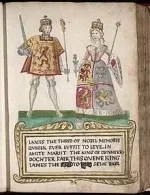Feb 20, 2020
Image: James III & Margaret, National Library of Scotland/Public Domain - wikipedia.com
On this day in 1472, Norway handed over the Orkney Isles and Shetland Isles to Scotland in lieu of a dowry for Margaret of Denmark according to historychannel.com.au.
The Isles are two inhabited archipelagos off the northeast coast of Scotland. Shetland, located some 80 kilometres to the north of Orkney, represents the northern most point of the United Kingdom. The islands are home to around 42,000 Scots and form an important part of Scotland’s tourist and fishing industries. But despite their Scottish status, there is something different about the cultures of both island communities, and it is perhaps not surprising that until early 1472, both archipelagos were Norwegian sovereign territory.
Despite their relative positions off mainland Scotland, Scandinavian interest in Orkney and Shetland was apparent from around the eighth century. Rapid population growth in western Scandinavia led to groups of Viking explorers sailing across the North Sea looking for new territories to settle. Both island groups were occupied by Viking settlers, with the indigenous populations being quickly subsumed.
The early Viking settlements were somewhat lawless entities, and Shetland in particular developed into a base for Viking pirates to conduct their raids into Norse waters. In 875, to protect his maritime interests, King Harald the Fair of Norway laid claim to what were known as the Northern Isles. The Northern Isles became a semi-autonomous Earldom, answerable to the Norwegian crown, and then in 1194, following a failed challenge to Norwegian authority, were brought under direct Norwegian rule.
This situation continued until the fifteenth century, when the intricacies of international diplomacy would dictate the future of the islands. In 1469, in an effort to subdue tensions between Scotland and Denmark, King James III was betrothed to Margaret of Denmark, daughter of Christian I, King of recently unified Denmark and Norway. A handsome dowry was arranged, but as Christian was short of financial clout, first Orkney and subsequently Shetland were offered as protection in lieu of payment.
When it became clear that the dowry money was not forthcoming, the fate of the islands became inevitable. In 1470 the long-established title Norse Earl of Orkney was officially ceded to James III, and on 20 February 1472, both Orkney and Shetland became official protectorates of the Scottish crown. Without the direct influence of Norwegian rule, the demographic profile of the islands gradually changed, and Scottish customs and culture superseded that of Norway.
Notwithstanding the change in sovereignty, the islands have never quite lost their sense of Scandinavian heritage. During the years of Norwegian influence, a distinct cultural identity, based on Scandinavian tradition, developed across the islands, and even though 500 years have passed since the end of Norwegian rule, aspects of that culture are still evident on Orkney and Shetland today. The literature and folklore of the islands are rich in elements of Norse mythology, and remains of Scandinavian dialect still betray the islands’ Nordic past. The natives of both archipelagos continue to take pride in their Norse heritage, and visitors to the islands will detect a distinct affinity with those from across the North Sea.
Share this article with friends!
Tags:
#orkney#and#shetland,#history,#dowry,#starzpsychics.com,#starz#advisors

